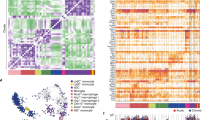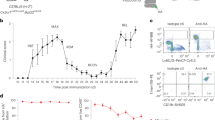Abstract
In multiple sclerosis and the experimental autoimmune encephalitis (EAE) mouse model, two pools of morphologically indistinguishable phagocytic cells, microglia and inflammatory macrophages, accrue from proliferating resident precursors and recruitment of blood-borne progenitors, respectively. Whether these cell types are functionally equivalent is hotly debated, but is challenging to address experimentally. Using a combination of parabiosis and myeloablation to replace circulating progenitors without affecting CNS-resident microglia, we found a strong correlation between monocyte infiltration and progression to the paralytic stage of EAE. Inhibition of chemokine receptor–dependent recruitment of monocytes to the CNS blocked EAE progression, suggesting that these infiltrating cells are essential for pathogenesis. Finally, we found that, although microglia can enter the cell cycle and return to quiescence following remission, recruited monocytes vanish, and therefore do not ultimately contribute to the resident microglial pool. In conclusion, we identified two distinct subsets of myelomonocytic cells with distinct roles in neuroinflammation and disease progression.
This is a preview of subscription content, access via your institution
Access options
Subscribe to this journal
Receive 12 print issues and online access
$209.00 per year
only $17.42 per issue
Buy this article
- Purchase on Springer Link
- Instant access to full article PDF
Prices may be subject to local taxes which are calculated during checkout







Similar content being viewed by others
References
Kreutzberg, G.W. Microglia: a sensor for pathological events in the CNS. Trends Neurosci. 19, 312–318 (1996).
Nimmerjahn, A., Kirchhoff, F. & Helmchen, F. Resting microglial cells are highly dynamic surveillants of brain parenchyma in vivo. Science 308, 1314–1318 (2005).
Raivich, G. Like cops on the beat: the active role of resting microglia. Trends Neurosci. 28, 571–573 (2005).
Streit, W.J., Walter, S.A. & Pennell, N.A. Reactive microgliosis. Prog. Neurobiol. 57, 563–581 (1999).
Lawson, L.J., Perry, V.H. & Gordon, S. Turnover of resident microglia in the normal adult mouse brain. Neuroscience 48, 405–415 (1992).
Hickey, W.F. & Kimura, H. Perivascular microglial cells of the CNS are bone marrow–derived and present antigen in vivo. Science 239, 290–292 (1988).
Priller, J. et al. Targeting gene-modified hematopoietic cells to the central nervous system: use of green fluorescent protein uncovers microglial engraftment. Nat. Med. 7, 1356–1361 (2001).
Hess, D.C. et al. Hematopoietic origin of microglial and perivascular cells in brain. Exp. Neurol. 186, 134–144 (2004).
Ajami, B., Bennett, J.L., Krieger, C., Tetzlaff, W. & Rossi, F.M. Local self-renewal can sustain CNS microglia maintenance and function throughout adult life. Nat. Neurosci. 10, 1538–1543 (2007).
Ginhoux, F. et al. Fate mapping analysis reveals that adult microglia derive from primitive macrophages. Science 330, 841–845 (2010).
Hickey, W.F. Migration of hematogenous cells through the blood-brain barrier and the initiation of CNS inflammation. Brain Pathol. 1, 97–105 (1991).
Hickey, W.F., Hsu, B.L. & Kimura, H. T-lymphocyte entry into the central nervous system. J. Neurosci. Res. 28, 254–260 (1991).
Swanborg, R.H. Experimental autoimmune encephalomyelitis in rodents as a model for human demyelinating disease. Clin. Immunol. Immunopathol. 77, 4–13 (1995).
Steinman, L., Martin, R., Bernard, C., Conlon, P. & Oksenberg, J.R. Multiple sclerosis: deeper understanding of its pathogenesis reveals new targets for therapy. Annu. Rev. Neurosci. 25, 491–505 (2002).
Santambrogio, L. et al. Developmental plasticity of CNS microglia. Proc. Natl. Acad. Sci. USA 98, 6295–6300 (2001).
Ulvestad, E. et al. Human microglial cells have phenotypic and functional characteristics in common with both macrophages and dendritic antigen-presenting cells. J. Leukoc. Biol. 56, 732–740 (1994).
Ponomarev, E.D., Shriver, L.P., Maresz, K. & Dittel, B.N. Microglial cell activation and proliferation precedes the onset of CNS autoimmunity. J. Neurosci. Res. 81, 374–389 (2005).
Heppner, F.L. et al. Experimental autoimmune encephalomyelitis repressed by microglial paralysis. Nat. Med. 11, 146–152 (2005).
Bauer, J. et al. The role of macrophages, perivascular cells, and microglial cells in the pathogenesis of experimental autoimmune encephalomyelitis. Glia 15, 437–446 (1995).
Huitinga, I., van Rooijen, N., de Groot, C.J., Uitdehaag, B.M. & Dijkstra, C.D. Suppression of experimental allergic encephalomyelitis in Lewis rats after elimination of macrophages. J. Exp. Med. 172, 1025–1033 (1990).
Brosnan, C.F., Bornstein, M.B. & Bloom, B.R. The effects of macrophage depletion on the clinical and pathologic expression of experimental allergic encephalomyelitis. J. Immunol. 126, 614–620 (1981).
Izikson, L., Klein, R.S., Charo, I.F., Weiner, H.L. & Luster, A.D. Resistance to experimental autoimmune encephalomyelitis in mice lacking the CC chemokine receptor (CCR)2. J. Exp. Med. 192, 1075–1080 (2000).
Fife, B.T., Huffnagle, G.B., Kuziel, W.A. & Karpus, W.J. CC chemokine receptor 2 is critical for induction of experimental autoimmune encephalomyelitis. J. Exp. Med. 192, 899–905 (2000).
Mildner, A. et al. CCR2+ Ly-6Chi monocytes are crucial for the effector phase of autoimmunity in the central nervous system. Brain 132, 2487–2500 (2009).
King, I.L., Dickendesher, T.L. & Segal, B.M. Circulating Ly-6C+ myeloid precursors migrate to the CNS and play a pathogenic role during autoimmune demyelinating disease. Blood 113, 3190–3197 (2009).
Kennedy, D.W. & Abkowitz, J.L. Kinetics of central nervous system microglial and macrophage engraftment: analysis using a transgenic bone marrow transplantation model. Blood 90, 986–993 (1997).
Li, Y.Q., Chen, P., Jain, V., Reilly, R.M. & Wong, C.S. Early radiation-induced endothelial cell loss and blood-spinal cord barrier breakdown in the rat spinal cord. Radiat. Res. 161, 143–152 (2004).
Diserbo, M. et al. Blood-brain barrier permeability after gamma whole-body irradiation: an in vivo microdialysis study. Can. J. Physiol. Pharmacol. 80, 670–678 (2002).
Mildner, A. et al. Microglia in the adult brain arise from Ly-6Chi CCR2+ monocytes only under defined host conditions. Nat. Neurosci. 10, 1544–1553 (2007).
Wright, D.E. et al. Cyclophosphamide/granulocyte colony-stimulating factor causes selective mobilization of bone marrow hematopoietic stem cells into the blood after M phase of the cell cycle. Blood 97, 2278–2285 (2001).
Mason, D. Genetic variation in the stress response: susceptibility to experimental allergic encephalomyelitis and implications for human inflammatory disease. Immunol. Today 12, 57–60 (1991).
Bukilica, M. et al. Stress-induced suppression of experimental allergic encephalomyelitis in the rat. Int. J. Neurosci. 59, 167–175 (1991).
Streit, W.J. Microglia and the response to brain injury. Ernst Schering Res. Found. Workshop 39, 11–24 (2002).
Krall, W.J., Challita, P.M., Perlmutter, L.S., Skelton, D.C. & Kohn, D.B. Cells expressing human glucocerebrosidase from a retroviral vector repopulate macrophages and central nervous system microglia after murine bone marrow transplantation. Blood 83, 2737–2748 (1994).
Jung, S. et al. Analysis of fractalkine receptor CX(3)CR1 function by targeted deletion and green fluorescent protein reporter gene insertion. Mol. Cell. Biol. 20, 4106–4114 (2000).
Saederup, N. et al. Selective chemokine receptor usage by central nervous system myeloid cells in CCR2–red fluorescent protein knock-in mice. PLoS ONE 5, e13693 (2010).
Carson, M.J., Thrash, J.C. & Walter, B. The cellular response in neuroinflammation: the role of leukocytes, microglia and astrocytes in neuronal death and survival. Clin. Neurosci. Res. 6, 237–245 (2006).
Engelhardt, B. Molecular mechanisms involved in T cell migration across the blood-brain barrier. J. Neural Transm. 113, 477–485 (2006).
Benveniste, E.N. Role of macrophages/microglia in multiple sclerosis and experimental allergic encephalomyelitis. J. Mol. Med. 75, 165–173 (1997).
Bauer, J., Sminia, T., Wouterlood, F.G. & Dijkstra, C.D. Phagocytic activity of macrophages and microglial cells during the course of acute and chronic relapsing experimental autoimmune encephalomyelitis. J. Neurosci. Res. 38, 365–375 (1994).
Kim, J.V., Kang, S.S., Dustin, M.L. & McGavern, D.B. Myelomonocytic cell recruitment causes fatal CNS vascular injury during acute viral meningitis. Nature 457, 191–195 (2009).
Getts, D.R. et al. Ly-6C+ 'inflammatory monocytes' are microglial precursors recruited in a pathogenic manner in West Nile virus encephalitis. J. Exp. Med. 205, 2319–2337 (2008).
Massberg, S. et al. Immunosurveillance by hematopoietic progenitor cells trafficking through blood, lymph, and peripheral tissues. Cell 131, 994–1008 (2007).
Nagai, Y. et al. Toll-like receptors on hematopoietic progenitor cells stimulate innate immune system replenishment. Immunity 24, 801–812 (2006).
Wujek, J.R. et al. Axon loss in the spinal cord determines permanent neurological disability in an animal model of multiple sclerosis. J. Neuropathol. Exp. Neurol. 61, 23–32 (2002).
Luster, A.D., Alon, R. & von Andrian, U.H. Immune cell migration in inflammation: present and future therapeutic targets. Nat. Immunol. 6, 1182–1190 (2005).
Yednock, T.A. et al. Prevention of experimental autoimmune encephalomyelitis by antibodies against alpha 4 beta 1 integrin. Nature 356, 63–66 (1992).
Miller, D.H. et al. A controlled trial of natalizumab for relapsing multiple sclerosis. N. Engl. J. Med. 348, 15–23 (2003).
Steinman, L. Blocking adhesion molecules as therapy for multiple sclerosis: natalizumab. Nat. Rev. Drug Discov. 4, 510–518 (2005).
Langer-Gould, A., Atlas, S.W., Green, A.J., Bollen, A.W. & Pelletier, D. Progressive multifocal leukoencephalopathy in a patient treated with natalizumab. N. Engl. J. Med. 353, 375–381 (2005).
Acknowledgements
We thank B. Chua, T. Godbey, K. Ranta, M. Cowan, L. Rollins and the Biomedical Research Center animal unit personnel for advice and help on animal welfare. We thank A. Johnson, C.K. Chang, J. Kang and D. Mahdaviani for their technical help. This work was supported by Canadian Institute for Health Research (CIHR, MOP 81382) grants and a grant from the Multiple Sclerosis Society of Canada to F.M.V.R., a Neuromuscular Research Partnership grant from the CIHR, a grant from the Amyotrophic Lateral Sclerosis Society of Canada and Muscular Dystrophy Canada to C.K. and F.M.V.R. (JNM-69682), a Collaborative Health Research grant from the CIHR and the Natural Science and Engineering Research Council of Canada to C.K. and F.M.V.R. (CHRP 299119), and a research grant from the Multiple Sclerosis Society of Canada to K.M.M. K.M.M. is a Michael Smith Foundation for Health Research Senior Scholar. B.A is supported by a Michael Smith Foundation Senior Graduate Studentship and a CIHR–Amyotrophic Lateral Sclerosis Doctoral Research Award. J.L.B. is supported by a Multiple Sclerosis Society of Canada Postdoctoral Research Fellowship. This research was undertaken, in part, thanks to funding from the Canadian Research Chairs program to F.M.V.R.
Author information
Authors and Affiliations
Contributions
B.A. designed and conducted all of the experiments, interpreted the data and wrote the manuscript. J.L.B. conducted the EAE induction and participated in the writing of the manuscript. C.K. and K.M.M. participated in the writing of the manuscript. F.M.V.R. designed and interpreted experiments and wrote the manuscript.
Corresponding author
Ethics declarations
Competing interests
The authors declare no competing financial interests.
Supplementary information
Supplementary Text and Figures
Supplementary Figures 1–11 and Supplementary Table 1 (PDF 11352 kb)
Rights and permissions
About this article
Cite this article
Ajami, B., Bennett, J., Krieger, C. et al. Infiltrating monocytes trigger EAE progression, but do not contribute to the resident microglia pool. Nat Neurosci 14, 1142–1149 (2011). https://doi.org/10.1038/nn.2887
Received:
Accepted:
Published:
Issue Date:
DOI: https://doi.org/10.1038/nn.2887
This article is cited by
-
Early involvement of peripherally derived monocytes in inflammation in an NMO-like mouse model
Scientific Reports (2024)
-
The aging mouse CNS is protected by an autophagy-dependent microglia population promoted by IL-34
Nature Communications (2024)
-
The niche matters: origin, function and fate of CNS-associated macrophages during health and disease
Acta Neuropathologica (2024)
-
Gateway reflexes describe novel neuro-immune communications that establish immune cell gateways at specific vessels
Bioelectronic Medicine (2023)
-
Physiology and diseases of tissue-resident macrophages
Nature (2023)



